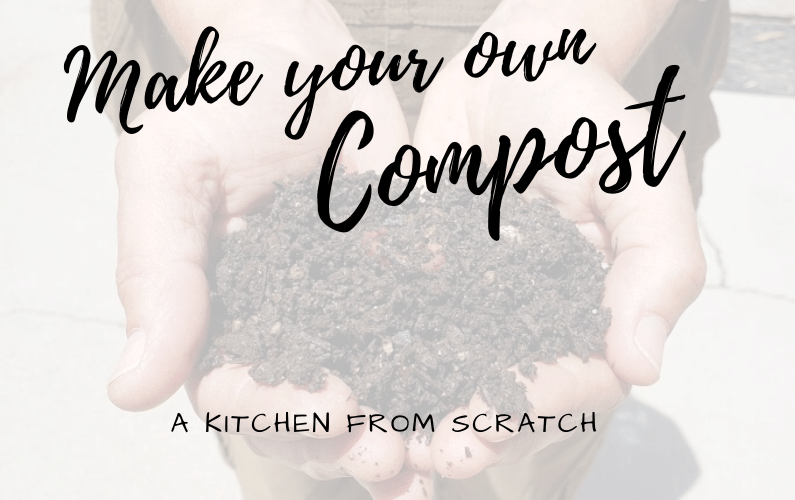Are you looking to save some money, reduce your waste footprint, become one with the earth, and enrich our little green friends in the garden? Green waste composting can be a solution for you even if you have a small space.
Composting is the best alternative to sending green waste out in your weekly trash pick-up. There are many options when choosing how you compost. Folks that live in a small space can use a vermicompost bin with red wiggler worms, done indoors. The most popular are
Start in the Kitchen
Having a container in the kitchen makes it easy to collect green waste to add to your compost recipe. In our house, we have a bucket under the sink, “the chicken bucket” when full it goes in the worm bin, to the chickens, or into a compost pile. If an ugly bucket is not your thing and you’re looking for something more attractive look at these stainless steel countertop worthy options.
Keep in mind that compost should not stink. If it does the microorganisms died, and you have a rotting pile. See the section troubleshooting below.
Cold composting
If you are not in a hurry and have 6 months to a year cold composting is your target. Simply add yard waste and organic materials from the garden and the kitchen and make a pile. Use a pitchfork to mix it up a bit on occasion and in about 6 to 12 months your pile should deliver some black compost. Not very efficient but this is how I started and it does work.
Hot composting
Hot composting takes a little more effort but is much faster about 1 to 3 months, and you will get increased yield to feed garden and flower beds. Hot compost is faster because of the mix of nitrogen, carbon, air, and water supply nutrients to the microorganisms, which speed up the process of decay. During the summer, when garden waste is abundant if you have a few batches started every few weeks, it will ensure a continuous source of black gold. Having a constant cycle is ideal to start and end your season with abundant compost.
Compost Recipe
Start by mixing one-part brown with two-part green materials and keep them moist and aerate occasionally. A rule of a green thumb, but if all you can manage to do is to add browns and greens as life demands based on the output you will eventually generate rich compost; it will take much longer. Measure parts in wheelbarrows, shovels, bags, or buckets. It sounds very scientific, but when you get that black fluffy compost, you will want to hug me. Don’t overwater your pile the goal is to keep it damp. If it becomes waterlogged, the microorganisms will drown, and we need them to keep the process going.
Green materials provide
protein through nitrogen for microorganisms—grass clippings, kitchen scratch, raw
fruits and vegetables, yard trimmings, garden waste, feathers, hops, hay, other
green plant debris.
Brown materials provide sugar through carbon for microorganisms –dried leaves, twigs, newspaper, straw, sawdust, paper products (napkins, tea bags, coffee filters, etc…), eggshells, dryer lint (if you don’t use softeners), wood chips, cardboard, wool, cotton scraps, coffee grounds.
Basically, before you toss anything to take a moment to see if it can be composted. There are a few items that need to be avoided in any compost recipe.
Avoid Adding to Compost
Avoid anything containing animal byproducts such as meat, oils, fats, grease, and dairy products. Discard any diseased plant material-no need to spread disease. Sawdust or chips from pressure-treated wood-it’s filled with chemicals that you don’t want to seep into the garden goodies. Altogether avoid dog or cat feces-it can cause severe illness. Weeds that go to seed- you don’t want to spread the weed seeds in your beautiful garden beds. Remember a “weed” is anything you don’t want in your garden. Weeds can include rooting plants like mint that will take over if not contained. If in doubt best be safe and avoid using in your compost recipe.
PRO TIP: Save garlic and ginger for the chickens or the trash as they repel the earthworms. Earthworms are essential for the garden we want them to stick around.
Compost Options
The first thing you will need to do is pick a location for your compost to live. Nothing is required for successful compost as the process happens naturally in nature. The easiest option is to start with the most basic heap, pile, or mound method. An unsightly mound of decaying materials can attract vermin and may not be the look you are going for. There are many DIY options and attractive composter models to purchase, such as the Tumbling Composter. A self-contained composter is an excellent option for beginners.
DIY Options
For my fellow DIYers constructing something is simple and can be done with a large plastic garbage can or plastic bin with a sealing lid to keep pests out. Start by drilling 1/2 inch holes at six-inch intervals down the side until it’s covered in evenly spaced polka dots. Drill half a dozen drainage holes in the bottom and add your greens, browns in layers water and aerate occasionally.
A household that produces a moderate amount of green waste using a wire composting bin is an excellent option. All you need is a 10-foot roll of medium-gauge wire mesh, chicken wire, or metal fencing and metal or wood steaks and four pieces of sturdy wire to ties it all together. All of these items are available at most home improvement stores. The wire mesh allows for airflow, and the lightweight structure can be easily moved to a new location, to turn a pile completely, or harvest from the bottom. The design allows moisture to evaporate and will need water more often.

The more advanced system and the most substantial home bin is built from ten to twelve pallets wired together and has three sections. The design allows for plenty of room for active composting and a place to store excess yard waste. Pallet bins is a space commitment as commercial pallets are generally 42 by 48 inches. Pallet bins are an excellent option if you have ample green waste and a large yard to build it. Combining mediums is a delightful alternative you can adjust to fit your needs.
Signs of success
On a cool morning if you see steam coming up from the compost pile, take pride you are feeding the microorganisms properly. They are happily creating heat from the diet supplied in the compost pile. The heat is produced from the microbes that reproduce, consume, and digest the pile, and in time will produce black gold—your garden will thank you in yields.
Troubleshooting a smelly situation
Compost should not smell bad if it does the first thing to check is if the pile is waterlogged. The goal is to keep it damp. Check by squeezing a handful of the compost if water seeps through your fingers, it’s too wet.
The decomposition process requires air to keep the aerobic oxygen-rich process going. The smell may be from not enough ventilation or anaerobic, which results in a dense, wet, slimy, and smelling of death. Check for proper ventilation if there is no air, it creates an environment for bacteria to thrive, not the beneficial organisms we need for decay. Get out your pitchfork or aerating device and start ventilating.
Using Compost
The best use for compost in the garden is before planting spread two inches over beds and till into soil. The compost improves soil conditions, holds moisture, resist erosion, and increase soil fertility. Fertilizers must be used infrequent and springily whereas compost can be added anytime anywhere in the garden, yard, or flowerbeds without risk to the plants. Compost adds nutrients and protection against many diseases commonly found in the garden.
Compost can be used on the lawn to increase new growth, in small pots or containers as a potting mixture, as mulch, and around the base of trees.
Compost or “black gold” takes very little hands-on time or effort and is less expensive than conventional fertilizer or mulch. It should not smell and will improve the texture of every kind of soil– indeed a gardener’s best friend. Composting is a win all the way around.
~Janine







